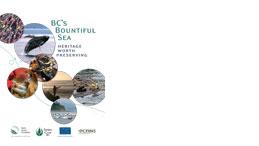Canada’s Pacific North Coast needs better management in the face of declining ocean health
VANCOUVER – Better management is needed to protect the diversity and abundance of marine life off British Columbia’s Pacific North Coast, one of the few places of its kind in the world, according to a publication released today by four conservation groups.
According to the report, BC’s Bountiful Sea: Heritage Worth Preserving, less than one per cent of the ocean in this region is designated as a protected area compared to almost 14 per cent of the province’s land base. Released today by the David Suzuki Foundation, Sierra Club BC, Living Oceans Society, and the Canadian Parks and Wilderness Society, the report offers an overview of the ocean’s bounty and the benefits it offers the people of the region, and indeed, all of Canada.
“If we hope to continue to enjoy the social and economic benefits that the ocean provides, governments need to engage in a thoughtful conservation planning process that will ensure healthy ocean environments for the future,” said Bill Wareham, senior conservation specialist at the David Suzuki Foundation. “I encourage all political parties and their candidates to commit to a greater investment in ocean management and conservation.”
In 2002, the Government of Canada officially recognized the need for a planning process to manage five of Canada’s most vulnerable ocean areas, including what it calls the Pacific North Coast Integrated Management Area (PNCIMA). Despite that recognition, Canada has done little to enhance the management and conservation of this 88,000-square-kilometre area stretching from the northern tip of Vancouver Island to the southern tip of Alaska.
“Climate change is creating an uncertain future for our ocean and, consequently, our communities,” said Living Oceans Society executive director Jennifer Lash. “The federal government must give the people who work and live on this coast the opportunity to build a management plan for the ocean that ensures healthy ecosystems in the face of climate change.”
CLICK HERE to download the report.
-30-
Contact Information
Bill Wareham, Senior Conservation Specialist, David Suzuki Foundation, (604) 740-4318; (604) 732-4228
Kim Wright, Marine Planning and Protected Areas Director, Living Oceans Society, (604) 696-5044
Lisa Hoffe, Communications Specialist, David Suzuki Foundation (604) 732-4228 ext. 278
Background
Pacific North Coast Area Facts
GLASS SPONGE REEFS - PNCIMA is home to 9,000-year-old reefs made of glass. The globally unique reefs have grown to the height of a five-storey building and cover 1,000 square kilometres. Scientists estimate that 50 percent of the reefs have been destroyed by bottom trawling and will take many hundreds of years to recover if at all.
MARINE LIFE – Twenty-seven different types of whales, dolphins, porpoises, seals, and sea lions can be found in PNCIMA. Many of these are threatened. Overall, 32 species living in PNCIMA waters are listed as endangered, threatened, or of special concern.
PROTECTION – More than 12 percent of B.C.’s land base is formally designated as protected area, where industrial activities are restricted. Less than one percent of B.C.’s ocean has the same kind of protection.
SEABIRDS – Seabirds nest and raise their young in PNCIMA in globally significant numbers. 80 percent of the world’s population of Cassin’s auklets are found on the Scott Islands. In 2005, only eight percent of the Cassin’s auklets pairs that laid an egg successfully hatched a chick.
SALMON – Twenty-five to 30 million adult salmon return to watersheds in PNCIMA every year. Six significant salmon runs in PNCMA have seriously declined in abundance and require immediate conservation measures for recovery.
FISHING - Almost every square kilometre of PNCIMA is important to the commercial fishing fleet in B.C. Three of B.C.’s five herring stocks are found in the region, averaging a total weight of 100,000 tonnes and constituting an important food base for many of the region’s marine animals. In 2008, for the first time in 25 years, the herring fishery on B.C.’s Central Coast was closed because of low abundance.
AQUACULTURE - Fifty-five percent of B.C.’s finfish aquaculture sites are located within PNCIMA.
SHIPPING - Over the next 15 years, the volume of containers being shipped through PNCIMA is expected to increase by 300 percent. Bulk cargo ships are expected to increase by 25 percent, presenting escalating pollution challenges.
TOURISM - Cruise-ship traffic is expected to increase by 20 to 25 percent. More than 900,000 passengers on 275 sailings travelled through PNCIMA from Vancouver to Alaska, generating an estimated $530,000 in sales taxes and 53 full-time equivalent jobs.
Many more details about the state of the environment in the PNCIMA can be found at:
- Ecosystem Overview: Pacific North Coast Integrated Management Area by Fisheries and Oceans Canada.
- Marine Use Analysis of the Pacific North Coast Integrated Management Area by Fisheries and Oceans Canada


